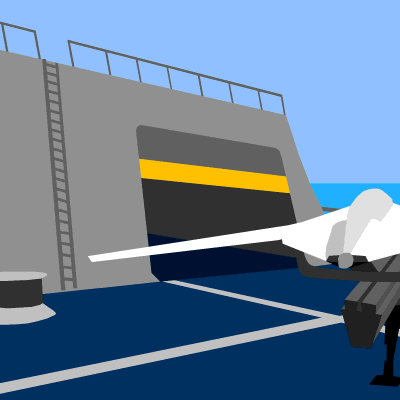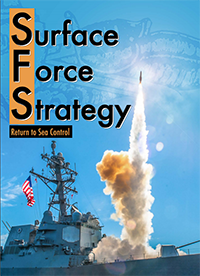In the future, every ship is a threat to adversary forces. Every asset has the ability to shoot…to react…to project power.
Because the calculus of sea control – and sea denial – is changing.
Today, our adversaries can shoot farther, with more precision and can do more damage than ever. The U.S. Navy is examining its force structure and operating concepts to stay ahead of these threats.
In a perfect warfighting scenario, the enemy’s location is known, and the Navy is able to precisely target their assets; however, with the proliferation of long-range missiles and the increasingly congested and contested information environment, warfighters need to operate in an uncertain battlespace.
“We teamed up with the Navy in a series of war-gaming exercises to understand the scenarios and challenges that sailors could potentially face,” said Glen Sears, senior strategy analyst for Lockheed Martin, and a retired U.S. Navy captain. “This collaboration helped us discover opportunities to develop capabilities or repurpose existing capabilities at all steps of the kill chain.”
“The Navy must be able to access any domain – and possess the mix of kinetic and non-kinetic weapons necessary to prevail today and tomorrow.”- Rear Adm. Mathias W. Winter, Chief of Naval Research.
Scout

Lockheed Martin concept of a ship launched UAV
Unmanned systems can be deployed with payloads, such as weapons or advanced sensors, tailored to the mission.
The kill chain starts with finding and identifying threats.
In close-range environments, smaller assets can deter and divert threats from larger strike groups. Whether a littoral combat ship or frigate, these ships are harder to detect, which means the adversary must use more resources to locate them.
Traditionally, these ships are paired with an aerial asset, like a Seahawk helicopter equipped with LINK 16 and HAWKLINK data links, to scout the adversary. As over-the-horizon capabilities become more critical, aerial assets like unmanned reconnaissance systems can be used for long-range operations – paired with either a manned helicopter to keep pilots out of harm’s way, or with another unmanned aerial vehicle (UAV). Unmanned systems can be deployed with payloads, such as weapons or advanced sensors, tailored to the mission.
As the F-35 Lightning II is integrated into military operations, it will serve as an airborne sensor that can relay data back to a ship at an even farther range than a UAV or helicopter. Through efforts such as Naval Integrated Fire Control-Counter Air (NIFC-CA), every platform will be a sensor and a shooter in the future fleet.
Decide

Data from multiple domains is most powerful when it’s networked. The military will share data across branches, platforms and systems, and collaborate with coalition forces as they reach the next stage of the kill chain: decision.
The future fleet will react to situations in seconds or minutes, which means that the Navy needs systems that can augment humans’ decision abilities.
The command, control, computing and communications technologies will expedite the decision-making process through automation, sensing and adaptive learning. These systems will help connect the threat to the response, and recommend the appropriate action and/or weapon system.
Today, we have implemented automated technologies that automatically assign aircraft and munitions based on the target, and programs that automatically route warfighters around dangerous locations. These technologies are helping to build trust in the human-machine team as we enter an era in which an attack could happen so quickly that humans can’t respond.
Engage

In an unpredictable threat environment, the ability to choose from a diverse group of weapons is critical. The Navy must possess the right mix of weapons to effectively engage.
While over-the-horizon missiles and precision-guided weapons are central to increasing the future fleet’s lethality, a combination of traditional kinetic weapons and emerging non-kinetic weapons will help the Navy succeed.
“Building platforms and systems with an open architecture is key to designing the future fleet,” Sears said. “At any given time, the Navy could need any given weapon, and that weapon will need to be integrated into the platform quickly and cost effectively.”
This means new systems, like LRASM or laser weapons, and modernized systems and sensors that have already been in service, like the Aegis Combat System. Through advances in power and miniaturization, engineers have constructed “Aegis in a box” that can make every ship a shooter without taking up considerable space. The weapon system takes the same proven technology and adapts it for the threats at hand.
The seamless integration of these systems and weapons is just as important as the modular approach.
“Systems integration is a huge part of mission readiness,” Sears said. “When the Navy needs to act, the systems need to work flawlessly.”
Deceive

Detection systems, like radar, emit waves into the electromagnetic spectrum that can be found by the enemy. Using radar decoys, simulated acoustics and simulated data links allows the Navy to confuse the enemy and expend resources on locating and engaging decoys. Electronic warfare countermeasures are key to controlling the environment.
“Deception has always been a part of war, but with the information age comes a growing need for dominating the electromagnetic spectrum and cyberspace,” Sears said.
New developments in sensor technologies, like the broadband electromagnetic aperture (BEMA), would allow the Navy to emulate multiple emissions in a small package. These sensors could go into a contested environment and listen, detect and process information before denying or diverting a potential threat.
Assess
Finally, at the end of the kill chain is the assessment. Through simulations and tabletop exercises, Navy and industry experts are still discovering how technology is changing operations and what capability gaps need to be filled.
“It’s about thinking differently, and testing out the scenarios our Navy may face in the near term. We need to be agile as we incorporate new technologies and their operational capabilities. And we must adapt the systems and platforms we have in place to provide a credible combat naval power,” Sears said.





